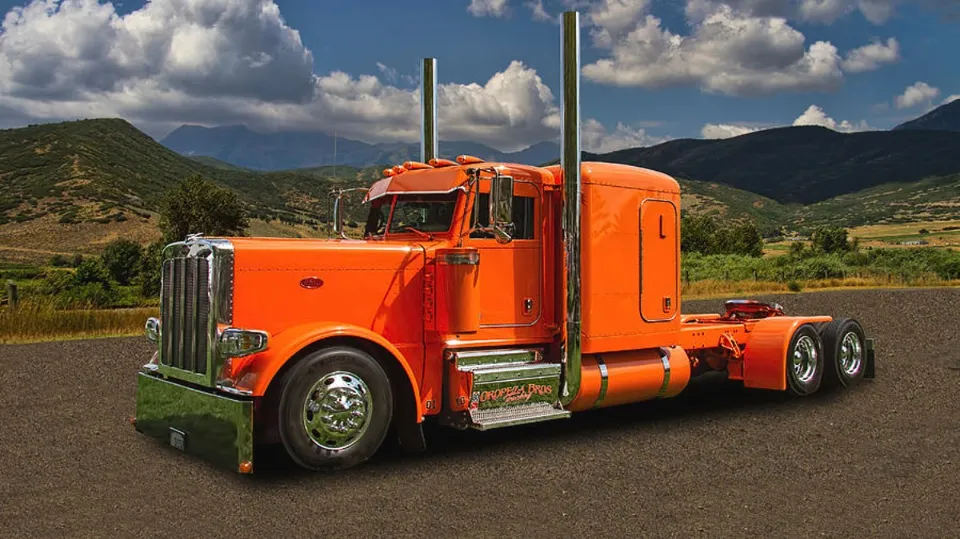You might need to know how long a semi-truck and trailer are for a number of reasons. Knowing the overall length of any vehicle left at your disposal is crucial for everything from parking arrangements to abiding by state laws. Fortunately, we have done our homework and have the solution for you!
From the front bumper to the end of the trailer, the typical semi-truck in the US is 72 feet long. Additionally, the length of the truck itself ranges from 48 to 53 feet.
We’ll examine these ranges now that we’re aware of the lengths of both the cabs and the trailers. You might also be curious about how trailer length is calculated or the lifespan of a semi-trailer. Continue reading for the solutions to these and other questions!
How Long is a Semi-Truck Without a Trailer?
A typical American semi-truck measures roughly 70 feet from the front bumper to the back of the trailer. The length of the cab, which can vary depending on the truck model, is not included in this measurement. 8.5 feet in width and 13.6 feet in height are the maximum dimensions for semi-trucks. To ensure that semi-trucks can travel on roads and highways safely, the Department of Transportation regulates these dimensions. Additionally, semi-trucks are required to have a minimum 40-foot wheelbase, which makes sure the vehicle will be stable when hauling large loads. In general, semi-trucks are large vehicles that have to abide by strict size requirements in order to operate on public roads.
What is a Semi-Truck Without a Trailer Called?
Bobtail trucks are semi-trucks without trailers. Bobtail trucks are frequently used to pick up or deliver goods. Typically, bobtail trucks are driven by truck drivers at the start of their shift to the location where their load will be picked up. Once attached, the cargo will be transported by the driver to its final location. At the end of the shift, the driver will detach the trailer and return the bobtail truck to the home base. There are times when bobtail trucks are used to make local deliveries that don’t call for a full-sized semi-truck. When compared to semi-trucks with trailers, bobtail trucks are smaller and easier to maneuver, making them ideal for crowded areas like city streets. In the field of transportation, bobtail trucks are very important.

Why is It Called a Semi-Truck?
A semi-truck is a vehicle made up of a tractor and a trailer. The trailer is the smaller piece attached to the back of the tractor, which is the big vehicle you see on the road. The term “semi” comes from the fact that the trailer is only partially attached to the tractor and can be detached when necessary. In order to move heavy loads of cargo over long distances, semi-trucks are used. They typically require special training and operating licenses and are considerably larger than regular trucks. Semi-trucks play a crucial role in ensuring that goods can be transported quickly and effectively, making them a vital component of the American economy.
What is the Difference Between a Semi-truck and a Truck?
The tractor unit’s ability to separate from the trailer unit makes semi-trucks unique. Whether you are a contractor for a variety of jobs or the owner of a trucking company, semi-trucks have an advantage over rigid trucks and trailers because of this feature. The two units can be roughly aligned without having to be perfectly aligned by having the tractor back up to the trailer. Minor alterations to the coupled units are possible after installing the fifth-wheel coupling’s kingpin. When transporting fragile or livestock-sensitive cargo, such as those, flexibility is essential. Decoupling is useful if either the tractor or the trailer needs maintenance. Additionally, if towing multiple trailers, one trailer can be unhooked without the others becoming disconnected. Overall, semi-trucks have a big advantage over other kinds of rigs because of their versatility.

How Many Miles Can a Semi-Truck Last?
A semi-truck will likely last longer than a typical passenger pickup truck, which may not come as a surprise to you. These devices are built to withstand heavy use and abuse.
The delivery of various goods across the country depends on engineering them to enjoy long distances on the road.
These trucks have much larger engines than comparable passenger trucks. Their size and construction will make them durable enough to travel between 750,000 and 1,000,000 miles on average.
That is more than four times the average truck’s lifetime mileage!
It goes without saying that any vehicle will require proper care to reach a high mileage milestone. These powerful trucks will last a long time if you:
Follow Routine Maitanance
The secret to getting the best mileage out of any engine is to carry out all factory-recommended maintenance.
By the manufacturer’s maintenance schedule, this has to be finished quickly.
Whether it’s regular oil and fluid changes or in-depth inspections of your belts, suspension, or other crucial components, preventative maintenance will go a long way in keeping any semi-truck on the road to the million-mile mark.
For information on what maintenance must be done and when it should be done, consult the owner’s manual. For the best outcomes, utilize a reliable and well-regarded neighborhood service center.
Use Quality Parts and Fluids
Don’t cut corners on these necessities! Even though using inexpensive fluids and parts will save you a few dollars up front, you could end up draining your bank account of hundreds or thousands of dollars over time.
The best components for your truck are those made by reliable companies. To learn what to expect, read expert reviews of any fluid or additive.

Drive Responsibly
The longevity of your truck is undoubtedly influenced by how you drive it. Unless absolutely necessary, avoid slamming on the brakes or the accelerator. Keep it spotless on the inside and out.
Maintaining it for a long time depends on treating it like the worthwhile investment that it is.
These large trucks are not cheap. The truck is typically the single largest investment an owner-operator will ever make in their trucking operation.
For the business to continue, it is essential to protect the truck from the inside out, drive it carefully, and perform all necessary maintenance.
How Many Gallons of Gas Does a Tanker Truck Hold?
According to the Federal Motor Carrier Association, a “tank vehicle” is any truck designed to carry multiple tanks with individual carrying capacities of 119 gallons each, and a total capacity of 1,000 gallons or more. However, fuel tankers frequently have much larger liquid storage capacities, with capacities of over 9,000 gallons being particularly common.

When Should You Replace Semi Trucks and Tanker Trailers?
We have seen that properly maintained equipment can last for many years. But that doesn’t imply that they ought to. You may technically continue to use your trucks and trailers as long as they pass DOT inspections. The jobs you can accept will be constrained, though, if you drive an old truck. If your truck or tanker is too old, the shippers may need more modern equipment and will look elsewhere. Older trucks and trailers also cost you more in maintenance and unplanned downtime.
Therefore, make replacement plans for your equipment on a regular basis, following a set cycle, rather than making the decision to run it until it breaks. A quick glance at leasing cycles can help determine the ideal time to hold onto a trucking asset, whether you buy it or lease it.
How Often Do Leasing Companies Replace Cabs and Trailers?
Many fleet owners would rather lease their equipment than buy it outright. You don’t have to worry as much about maintenance or upkeep when you lease with a full service contract, and the lease cycle replaces trucks and trailers well before they are close to the end of their useful lives.
While equipment replacement cycles will differ from one lease to the next, it’s common to lease trucks on a five- or six-year cycle, and trailers on a two- to-five year cycle. This implies that you get a new cab and trailer every five years, give or take. Although they might not always be brand-new, leasing companies make sure that the vehicles are reliable and mechanically sound.
The five-year rule is a good place to start when planning your business expenses for trucking companies that own their equipment because it allows them to get more value from their investments. Let’s look more closely at the last question in this FAQ, which is about trucking costs, and how to reliably keep the cash flow you need to keep up with the replacement cycle.

Summary: How Long is a Semi Truck?
The average length of a semi-truck and trailer in the United States is merely a guide to the types you’ll most frequently see on the highways.
There are many different types of trucks and trucks suited for various shipping needs. All of these trucks are heavy-duty workhorses that can travel up to a million miles before needing to be replaced. Drive safe!
